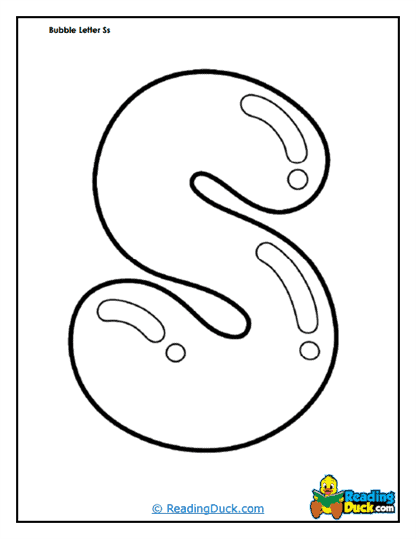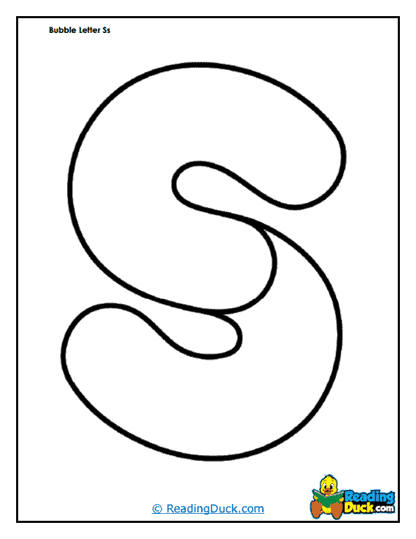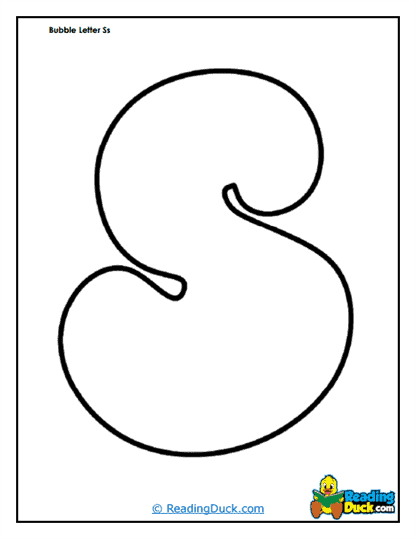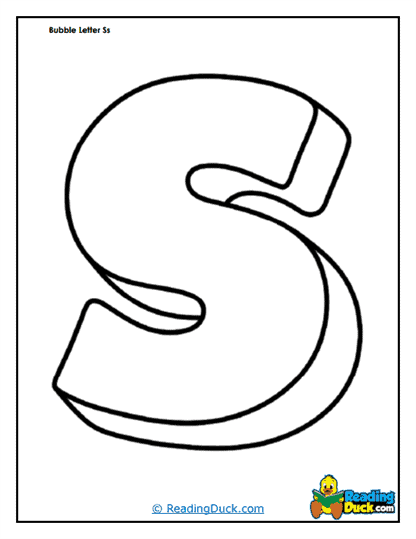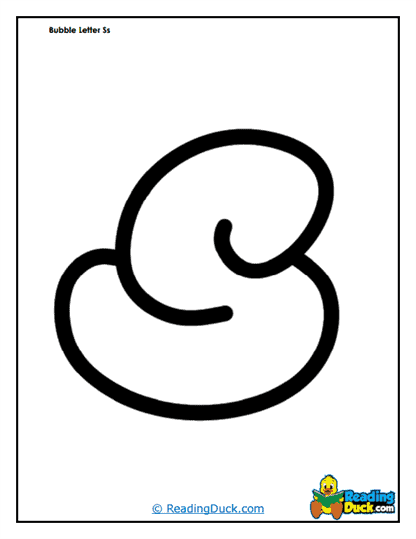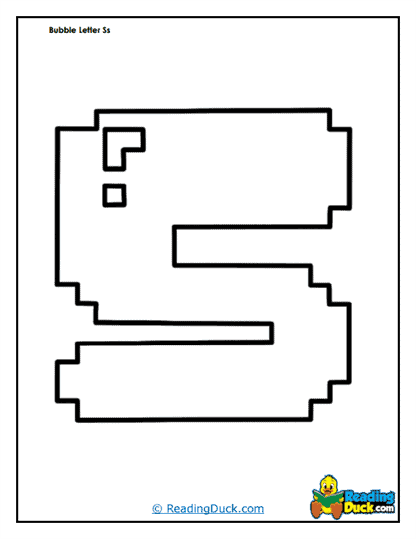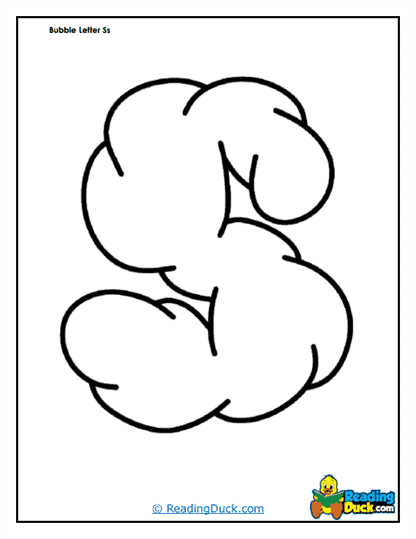Bubble Letter Ss Worksheets
About Our Bubble Letter Ss Worksheets
This sequence of worksheets serves as a creative avenue for students to improve their fine motor skills while mastering the formation of the letter "S." These worksheets often feature large, exaggerated, and stylized outlines of the letter, resembling playful bubble shapes that invite interaction. By practicing tracing these shapes, students not only refine their ability to write neatly but also strengthen the muscles in their hands, which are essential for writing endurance and precision. The design of these worksheets caters to a range of learning styles, blending visual, tactile, and kinesthetic elements to keep young learners engaged. This multifaceted approach not only fosters foundational handwriting skills but also introduces students to artistic expression, as they can personalize their work through coloring and embellishment.
In addition to supporting handwriting development, they encourage creativity and self-expression. By offering opportunities to decorate and fill in the bubble letters with patterns, colors, or even drawings, these worksheets make the learning process more enjoyable and memorable. For example, students might fill the "S" with stripes, polka dots, or their favorite colors, turning a routine writing exercise into a personalized art project. This element of customization boosts confidence and keeps students motivated, particularly those who may find traditional handwriting practice monotonous or challenging. Moreover, these activities help children develop spatial awareness and hand-eye coordination as they carefully navigate the contours of the letter, fostering a sense of accomplishment when their finished work reflects their effort and imagination.
Beyond the immediate focus on handwriting, this type of work can serve as a gateway to broader educational and developmental goals. Teachers and parents can integrate these worksheets into themed lessons, such as exploring words that begin with the letter "S" or creating stories that feature objects decorated with bubble letters. This approach reinforces phonetic awareness and vocabulary development, connecting handwriting practice to language skills in meaningful ways. Furthermore, these worksheets can be used collaboratively, encouraging social interaction as students share their creations or work together on group projects. Whether used in classrooms, homeschooling environments, or therapy sessions, Bubble Letter "S" Worksheets are an adaptable and engaging tool that combines learning, creativity, and play to foster a well-rounded educational experience.
Improving Pencil or Pen Manipulation
Development of Fine Motor Skills
Bubble letters are often larger than standard letter forms, requiring students to engage in broader and more deliberate movements with their arm, wrist, and fingers. These larger strokes necessitate the use of arm muscles in addition to fine hand movements, promoting the development of motor strength and endurance. As students repeatedly practice drawing bubble letters, they build the fine motor control needed for intricate tasks like writing smaller letters or detailed drawings. Additionally, the varied shapes and curves of letters like "S" introduce students to a wide range of motions, such as smooth arcs, tight loops, and controlled transitions, which refine precision and dexterity. Over time, this practice not only strengthens the necessary muscles but also builds confidence in handling a pencil or pen effectively for both creative and academic purposes.
Hand-Eye Coordination
Tracing bubble letters involves aligning pencil strokes accurately within outlined shapes, which requires a close interplay between what the eyes perceive and how the hand moves. This activity fosters focused attention, as students must concentrate on staying within the lines while maintaining the correct proportions of the letter. The precise coordination needed for such tasks translates directly to improved handwriting skills, where alignment and spacing are critical. By practicing with bubble letters, students also learn to control their speed and steadiness, reducing the shakiness often seen in early writing efforts. This improvement in hand-eye coordination not only enhances handwriting but also benefits other activities requiring similar precision, such as cutting with scissors or tying shoelaces.
Grip and Pressure Control
Bubble letter tracing encourages students to develop a steady and balanced grip on their writing tool, which is crucial for effective handwriting. Maintaining consistent pressure is essential, as applying too much force can break the pencil tip or tear the paper, while too little pressure results in faint or incomplete lines. Through repeated practice, students become more attuned to how tightly they should hold their pencil and how much force to exert, leading to better overall control. This awareness extends to other writing tasks, where consistent grip and pressure are needed for neat and legible results. Furthermore, developing these skills early helps prevent bad habits like an overly tight grip, which can lead to hand fatigue or discomfort during longer writing sessions.
Spatial Awareness
Bubble letters provide a structured space for students to practice letter formation, helping them develop a sense of spatial awareness. By working within the confines of the outlined shapes, students learn to understand concepts such as proportion, alignment, and spacing. This practice teaches them how to position their strokes correctly within a designated area, an essential skill for writing on lined paper. These spatial skills also extend to art and design tasks, where understanding balance and placement is critical. Over time, consistent practice with bubble letters helps students internalize these spatial principles, leading to improved organization and aesthetics in their handwriting and drawings.
Foundational Literacy Skills
1. Letter Recognition
Practicing bubble letters enhances students' ability to visually recognize the letter "S" by exposing them to its shape in an enlarged and exaggerated format. This repeated exposure helps solidify their understanding of the letter's unique features, making it easier to identify in different contexts, such as books, signs, or digital screens. As students grow familiar with the curves and overall structure of the letter, they develop fluency in recognizing it across various fonts and styles. This skill is a critical step in building reading proficiency, as it ensures that the letter "S" becomes instantly recognizable within words. Strengthened letter recognition aids in quicker word decoding and smoother reading experiences.
2. Enhanced Focus on Letter Shapes and Features
Tracing and coloring bubble letters requires students to pay close attention to the unique features of the letter "S," such as its curves, loops, and overall structure. This detailed focus helps them differentiate between similar-looking characters, such as the number "5," reducing potential confusion during reading and writing. Additionally, the process engages multiple senses, combining visual and tactile input to reinforce the letter's identity in their memory. This multi-sensory approach ensures that the letter "S" is not only visually but also physically ingrained in their learning experience. The result is a deeper, more robust understanding of the letter's shape and function in language.
3. Strengthening Alphabetic Principles
Through bubble letter activities, students reinforce their understanding that letters represent specific sounds, a fundamental concept of phonics. Associating the letter "S" with its sound (/s/) bridges the gap between visual recognition and auditory processing. This connection is essential for decoding words, as students learn to blend individual sounds into complete words. By repeatedly practicing this association, students strengthen their grasp of the alphabetic principle, which underpins all phonics-based reading instruction. Mastery of these principles lays a strong foundation for reading and writing fluency.
4. Repetition and Retention
Repeated exposure to the letter "S" through tracing, coloring, and other creative activities enhances students' memory of both its visual form and its corresponding sound. This constant reinforcement ensures that the letter becomes second nature, speeding up the recognition process when encountered in texts. Over time, this familiarity contributes to more efficient reading, as students no longer need to pause to identify individual letters. The retention gained through such practice also aids in spelling, as students become more confident in recalling and reproducing the letter accurately. This confidence translates to improved overall literacy skills, as foundational knowledge builds upon itself.
5. Vocabulary Building
Bubble letter worksheets can be integrated into activities that teach new words beginning with "S," such as "sun," "snake," or "star." By associating the letter with meaningful words, students expand their sight-word vocabulary while solidifying their understanding of its sound. This dual focus on letter and vocabulary development strengthens their reading and writing skills simultaneously. Additionally, connecting the letter to real-world objects makes learning more engaging and memorable. These vocabulary-building exercises encourage students to explore language more deeply, fostering a love for words and their meanings.
6. Improving Reading Fluency
Mastery of individual letters, such as "S," through bubble letter activities is crucial for reading fluency. When students can quickly and accurately recognize letters, they can transition seamlessly to identifying whole words and sentences. This ability to process text efficiently reduces cognitive load, allowing them to focus on comprehension rather than decoding. Fluency gained through bubble letter practice contributes to smoother, more confident reading experiences. Ultimately, this improvement in fluency supports academic success, as reading becomes a faster and more enjoyable process.

